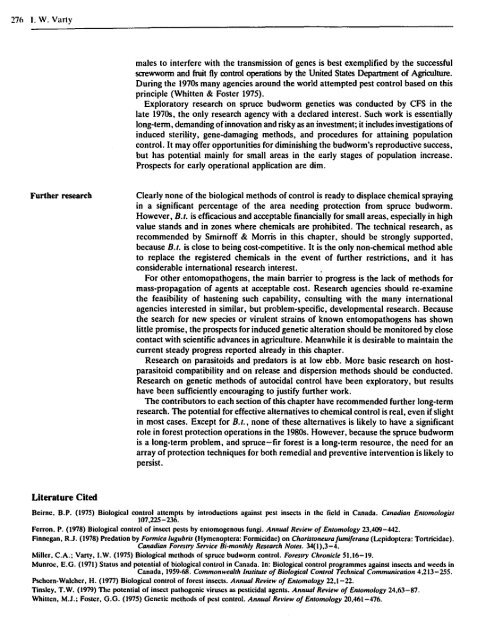pdf, 57.71Mb - Entomological Society of Canada
pdf, 57.71Mb - Entomological Society of Canada
pdf, 57.71Mb - Entomological Society of Canada
You also want an ePaper? Increase the reach of your titles
YUMPU automatically turns print PDFs into web optimized ePapers that Google loves.
276 I. W. Varty<br />
Further research<br />
Literature Cited<br />
males to interfere with the transmission <strong>of</strong> genes is best exemplified by the successful<br />
screwworm and fruit fly mntrol operations by the United States Department <strong>of</strong> Agriculture.<br />
During the 1970s many agencies around the world attempted pest control based on this<br />
principle (Whitten & Foster 1975).<br />
Exploratory research on spruce budworm genetics was conducted by CFS in the<br />
late 1970s, the only research agency with a declared interest. Such work is essentially<br />
long-term, demanding <strong>of</strong> innovation and risky as an investment; it includes investigations <strong>of</strong><br />
induced sterility, gene-damaging methods, and procedures for attaining population<br />
control. It may <strong>of</strong>fer opportunities for diminishing the budworm's reproductive success,<br />
but has potential mainly for small areas in the early stages <strong>of</strong> population increase.<br />
Prospects for early operational application are dim.<br />
Clearly none <strong>of</strong> the biological methods <strong>of</strong> control is ready to displace chemical spraying<br />
in a significant percentage <strong>of</strong> the area needing protection from spruce budworm.<br />
However, B.I. is efficacious and acceptable financially for small areas, especially in high<br />
value stands and in zones where chemicals are prohibited. The technical research, as<br />
recommended by Smirn<strong>of</strong>f & Morris in this chapter, should be strongly supported,<br />
because B.I. is close to being cost-competitive. It is the only non-chemical method able<br />
to replace the registered chemicals in the event <strong>of</strong> further restrictions, and it has<br />
considerable international research interest.<br />
For other entomopathogens, the main barrier to progress is the lack <strong>of</strong> methods for<br />
mass-propagation <strong>of</strong> agents at acceptable cost. Research agencies should re-examine<br />
the feasibility <strong>of</strong> hastening such capability, consulting with the many international<br />
agencies interested in similar, but problem-specific, developmental research. Because<br />
the search for new species or virulent strains <strong>of</strong> known entomopathogens has shown<br />
little promise, the prospects for induced genetic alteration should be monitored by close<br />
contact with scientific advances in agriculture. Meanwhile it is desirable to maintain the<br />
current steady progress reported already in this chapter.<br />
Research on parasitoids and predators is at low ebb. More basic research on hostparasitoid<br />
compatibility and on release and dispersion methods should be conducted.<br />
Research on genetic methods <strong>of</strong> autocidal control have been exploratory, but results<br />
have been sufficiently encouraging to justify further work.<br />
The contributors to each section <strong>of</strong> this chapter have recommended further long-term<br />
research. The potential for effective alternatives to chemical control is real, even if slight<br />
in most cases. Except for 8.1., none <strong>of</strong> these alternatives is likely to have a significant<br />
role in forest protection operations in the 1980s. However, because the spruce budworm<br />
is a long-term problem, and spruce-fir forest is a long-term resource, the need for an<br />
array <strong>of</strong> protection techniques for both remedial and preventive intervention is likely to<br />
persist.<br />
Beirne. B.P. (1975) Biological control attempts by introductions against pest insects in the field in <strong>Canada</strong>. Canadian Entomologist<br />
107.225-236.<br />
Ferron. P. (1978) Biological control <strong>of</strong> insect pests by entomogenous fungi. Annual Review <strong>of</strong> Entomology 23.409-442.<br />
Finnegan. R.J. (1978) Predation by Formica lugubris (Hymenoptera: Formicidae) on Choristoneura fumiferana (Lepidoptera: Tonricidae).<br />
Canadian Forestry Service Bi-monthly Research Notes. 34(1).3-4.<br />
Miller. C.A.; Vanyo I.W. (1975) Biological methods <strong>of</strong> spruce budworm control. Forestry Chronicle 51.16-19.<br />
Munroe. E.G. (1971) Status and potential <strong>of</strong> biological control in <strong>Canada</strong>. In: Biological control programmes against insects and weeds in<br />
<strong>Canada</strong>. 1959·68. Commonwealth Institule <strong>of</strong> Biological Control Technical Communication 4.213-255.<br />
Pschorn-Walchcr. H. (1977) Biological control <strong>of</strong> forest insects. Annual Review <strong>of</strong> Entomology 22.1-22.<br />
TInsley. T.W. (1979) The potential <strong>of</strong> insect pathogenic viruses as pesticidal agents. Annual Review <strong>of</strong> Entomology 24.63-87.<br />
Whitten. M.J.; Foster. G.G. (1975) Genetic methods <strong>of</strong> pest control. Annual Review <strong>of</strong> Entomology 20.461-476.
















